Elijah Wald – Narcocorrido
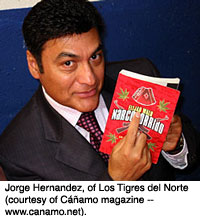 Página
en Español
Página
en Español
Radio interviews and book review links
Corrido article
"El Corrido de Elijah", a tribute from a talented fan.
Lyrics page for the accompanying CD.
Corrido Watch, a page of topical songs, including several corridos of the World Trade Center bombing.
Corrido Censorship, a timeline of efforts to ban the broadcast of narcocorridos.
Corridos on YouTube, a brief survey of some styles represented in the newest international forum of the corrido world.
A chapter that was cut from the published book, and other interviews with corridistas, including Jorge Hernandez of Los Tigres del Norte, Reynaldo Martinez, Rafael Buendia, Nacho Hernandez, and Beto Quintanilla.
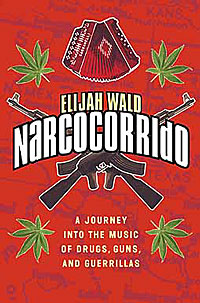 Narcocorrido:
A Journey into the Music of Drugs, Guns, and Guerrillas, published in English and Spanish
editions from Rayo, an imprint of HarperCollins Publishing.
Narcocorrido:
A Journey into the Music of Drugs, Guns, and Guerrillas, published in English and Spanish
editions from Rayo, an imprint of HarperCollins Publishing.
2002 Latino Book Award winner as "Best Arts Book"
This is the first full-length exploration of the contemporary Mexican corrido, blended with a travel narrative and digressions on Mexican and Mexican immigrant culture. Corridos account for some of the biggest sales in the Latino market, both in the US and points south. While the Anglo media pretends that the boom in Latin music is driven by salsa and Afro-Caribbean rhythms, most US Latin sales are of Mexican music and a large proportion of these are drug trafficking ballads, played in polka or waltz time by accordion combos or brass bands. Many of these ballads are in the classic Medieval style, and are a direct link between the earliest European poetic traditions and the world of crack cocaine and gangsta rap.
Narcocorrido is a series of visits with corridistas, from the most popular urban composers to rural singers documenting current events in their communities. It was researched over roughly a year, traveling all over Mexico and the southwestern US, largely by hitchhiking. I went up into the drug trafficking regions, searched out the foremost composers in their homes, and listened to every cassette the truck drivers threw on their tape decks. This book is currently out of print, but a new, updated edition is in the works.
"Through the stories of the corrido-crafters themselves, Wald
uncovers a world desperate for heroes. At once tragic and hopeful, the
result of his journey holds a mirror up to life on both sides of the
border."
--Louie Perez, of Los Lobos
"Narcocorrido is more than an exposé of a musical genre
and a contemporary problem, it is a journey into the complex nuances of
Mexican social and cultural history. Wald's book is a most significant
contribution to the bibliography on travel literature by foreign
observers to Mexico since colonial times. It will be of interest to a
wide range of specialists in diverse fields, as well as to the casual
reader who will enjoy the pleasure of a rich narrative of adventure and
detective work."
--Guillermo E. Hernández, Ph.D., Director of the UCLA-Chicano
Studies Research Center
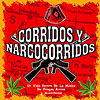 There
was a companion
CD for the book issued by Fonovisa, with tracks by Los Tigres del
Norte,
Chalino Sánchez, Luis y Julián, Grupo Exterminador, Jenni
Rivera, Pedro Rivera, Los Hermanos Jiménez, El Canelo y los Dos
del Sitio, and Los Pajaritos del Sur. Unfortunately, it went out of
print when Fonovisa merged with Univision, but copies may still turn
up, andlyrics to
all but one of the songs are on my corrido
cd lyrics page.
There
was a companion
CD for the book issued by Fonovisa, with tracks by Los Tigres del
Norte,
Chalino Sánchez, Luis y Julián, Grupo Exterminador, Jenni
Rivera, Pedro Rivera, Los Hermanos Jiménez, El Canelo y los Dos
del Sitio, and Los Pajaritos del Sur. Unfortunately, it went out of
print when Fonovisa merged with Univision, but copies may still turn
up, andlyrics to
all but one of the songs are on my corrido
cd lyrics page.
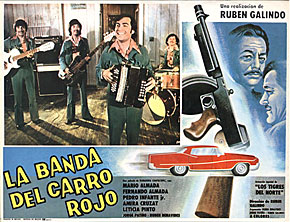 Section
One: Corrido Renaissance explores the rise of the
narcocorrido in the early 1970s, with the groundbreaking hits of Los
Tigres del Norte, the dominant band in the field for the last 30 years.
Los Tigres are kind of a Mexican equivalent of the Rolling Stones and
Willie Nelson combined, the biggest "roots music" stars on the scene.
Their albums sell in the millions, and their concerts can draw upwards
of 100,000 screaming fans.
Section
One: Corrido Renaissance explores the rise of the
narcocorrido in the early 1970s, with the groundbreaking hits of Los
Tigres del Norte, the dominant band in the field for the last 30 years.
Los Tigres are kind of a Mexican equivalent of the Rolling Stones and
Willie Nelson combined, the biggest "roots music" stars on the scene.
Their albums sell in the millions, and their concerts can draw upwards
of 100,000 screaming fans.
1. The Father of Camelia: Angel González is a visit with the composer of "Contrabando y Traición," the saga of a marijuana smuggler known as "Camelia la Tejana," which started the narcocorrido boom.
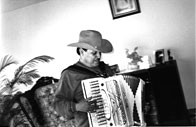 2. El Maestro: Paulino Vargas (pictured right)
introduces the most influential writer in the narcocorrido world, an
earthy poet who has been documenting the Mexican underworld for over
thirty years. Paulino is also a wonderfully entertaining character, and
was accordionist for one of the defining norteño groups, Los
Broncos de Reynosa. (for hi-res copy of photo, click
here)
2. El Maestro: Paulino Vargas (pictured right)
introduces the most influential writer in the narcocorrido world, an
earthy poet who has been documenting the Mexican underworld for over
thirty years. Paulino is also a wonderfully entertaining character, and
was accordionist for one of the defining norteño groups, Los
Broncos de Reynosa. (for hi-res copy of photo, click
here)
 Section
Two: The Sinaloan Sound Sinaloa is the heartland of Mexico’s
drug traffickers, and is the seat of the current narcocorrido
mainstream. The birthplace of Los Tigres and hundreds of other artists,
it is also the home of banda, or pop brass band music.
Section
Two: The Sinaloan Sound Sinaloa is the heartland of Mexico’s
drug traffickers, and is the seat of the current narcocorrido
mainstream. The birthplace of Los Tigres and hundreds of other artists,
it is also the home of banda, or pop brass band music.
3. Sinaloan Legends: Narcoculture, Violence and Jesús Malverde explores the Sinaloan milieu, with a not to the narco-intellectuals and artists of Culiacán, and a visit to the chapel of Jesús Malverde, patron saint of the drug traffic.
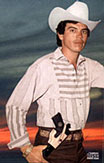 4. El Valiente: Chalino
Sánchez (pictured left) traces the life and legend of the
toughest corridista of them all, who has become the dominant influence
on the young West Coast singers. Chalino was a supreme badass, who shot
to international fame after a show in Southern California during which
a guy tried to assasinate him and he returned fire from the stage.
Shortly thereafter, he was gunned down in Sinaloa, but his immitators
are still heard from Mazatlán to Los Angeles. This chapter
includes a visit to Pepe Cabrera, a Sinaloan corridista who has been
one of the great behind-the-scenes influences in the field.
4. El Valiente: Chalino
Sánchez (pictured left) traces the life and legend of the
toughest corridista of them all, who has become the dominant influence
on the young West Coast singers. Chalino was a supreme badass, who shot
to international fame after a show in Southern California during which
a guy tried to assasinate him and he returned fire from the stage.
Shortly thereafter, he was gunned down in Sinaloa, but his immitators
are still heard from Mazatlán to Los Angeles. This chapter
includes a visit to Pepe Cabrera, a Sinaloan corridista who has been
one of the great behind-the-scenes influences in the field.
5. Chalinitos: El As de la Sierra (pictured
right) explores the "Chalinito" craze, and meets with El As de la
Sierra, the most successful of the Sinaloan-based narco stars, along
with his bodyguards.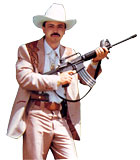
6. Badiraguato is a brief trip up into the heart of the drug region, to visit Antonio Uriarte, a local songwriter and record producer. (His most famous group, El Canelo de Sinaloa y Los Dos del Sitio, features two acoustic guitars and tuba.)
7. New Generation: Mario Quintero y los Tucanes de Tijuana is a visit with the most popular young band on the scene, the group that upped the ante for drug songs by singing not only about brave traffickers, but also about cocaine parties. Mario defends his paeans to famous drug lords, and explains the populist roots of the trend.
8. The Clown Prince: Francisco Quintero visits "El Vampiro," composer of comic narco songs like "Las Monjitas." ("The Little Nuns," about a pair of women traffickers who disguise themselves as nuns and their cocaine as powdered milk for an orphanage in Phoenix.)
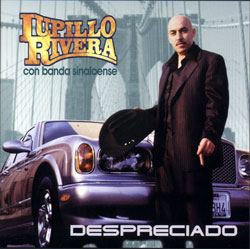 9.
Gangsta Corrido Dynasty: The Rivera Family
The first family of Los Angeles, the Riveras have ruled the local
corrido scene ever since patriarch Pedro Rivera signed Chalino to his
Cintas Acuario record label. No
9.
Gangsta Corrido Dynasty: The Rivera Family
The first family of Los Angeles, the Riveras have ruled the local
corrido scene ever since patriarch Pedro Rivera signed Chalino to his
Cintas Acuario record label. No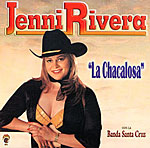 w, Pedro
writes topical corridos about subjects like the Rodney King riots and
the Gulf War, while his kids, Lupillo, Jenni and Juan, lead the
"gangsta" wing of the corrido trend, cutting the heaviest drug songs in
the corrido world for an audience of Chicanos who grew up on rap and
hip-hop.
w, Pedro
writes topical corridos about subjects like the Rodney King riots and
the Gulf War, while his kids, Lupillo, Jenni and Juan, lead the
"gangsta" wing of the corrido trend, cutting the heaviest drug songs in
the corrido world for an audience of Chicanos who grew up on rap and
hip-hop.
10. Cage of Gold: Enrique Franco travels to Tijuana to meet the man who brought a conscience to the modern corrido world, writing hits for Los Tigres that explored the immigrant experience, pan-Latino unity, and human rights issues.
11. The Political Circus: Jesse Armenta moves to Phoenix and the composer of Los Tigres’ hardest-hitting new political songs, including "El Circo," a satiric ballad of the Salinas presidency which became one of the group’s biggest hits.
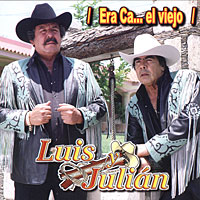 Section
Four: Norteño Heartland travels to the Texas border
region, where most experts believe that the corrido was born.
Section
Four: Norteño Heartland travels to the Texas border
region, where most experts believe that the corrido was born.
12. Trucker to Troubadour: Julián Garza is a visit with one of the most entertaining, rowdy, and funny men in the corrido world, and also one of the biggest hitmakers and most traditionally-oriented composers, the writer and lead voice of the duo Luis y Julián.
12b. A web special--this chapter was deleted from the published book, but a version can be read online by clicking here. Titled Reynaldo Martinez and the Balladeers of the Border, it includes interviews with three corridistas from Reynosa: Martinez, Beto Quintanilla, and Juan Villareal. You can read a copy here.
13. Faded Glories: Texas and the Valley explores the question of why the corrido seems to be dying out in the region where it once ruled supreme.
Section Five: Mexico City and Points South is a round-up of what is happening on the fringes of the pop corrido scene, ending with a visit to the most successful composer of all.
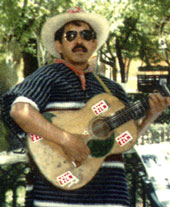 14. The Zapatista
Minstrel: Andrés Contreras (pictured left) is a rowdy,
obscene, and intensely political singer, who travels throughout Mexico
singing his revolutionary songs in city plazas, and getting thrown in
jail for his trouble. This chapter looks at the topical corrido
tradition since the 1960s, with a nod to the nueva canción
artists of the urban intelligentsia.
14. The Zapatista
Minstrel: Andrés Contreras (pictured left) is a rowdy,
obscene, and intensely political singer, who travels throughout Mexico
singing his revolutionary songs in city plazas, and getting thrown in
jail for his trouble. This chapter looks at the topical corrido
tradition since the 1960s, with a nod to the nueva canción
artists of the urban intelligentsia.
15. Corridos of the Country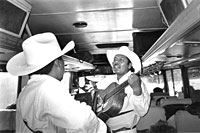 Buses: Gabriel Villanueva (pictured right) is a visit with an
old-fashioned singer who presents his ballads of current events on the
buses outside Acapulco, and has sold thousands of cassettes featuring
his ballads of Hurricane Pauline and the massacre in Aguas Blancas.
(For a hi-res copy of this photo, click here)
Buses: Gabriel Villanueva (pictured right) is a visit with an
old-fashioned singer who presents his ballads of current events on the
buses outside Acapulco, and has sold thousands of cassettes featuring
his ballads of Hurricane Pauline and the massacre in Aguas Blancas.
(For a hi-res copy of this photo, click here)
16. Guerrilla Corridos: The Mountains of Atoyac roams the region around Atoyac, the stomping grounds of Mexican guerrilla bands ever since the 1970s. Here, amateur singers perform their ballads of government massacres and guerrilla confrontations for small, sometimes clandestine gatherings of local villagers.
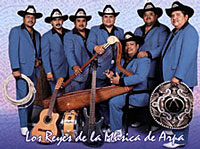 17. Norcocorridos Move
South: Apatzingán
17. Norcocorridos Move
South: Apatzingán
18. El Jefe de Jefes: Teodoro Bello winds the book up with a visit to Mexico’s top-selling composer, author of "Pacas de a Kilo" (One-Kilo Packages) and hundreds of hits for Los Tigres and just about everybody else in "Mexican regional" music.
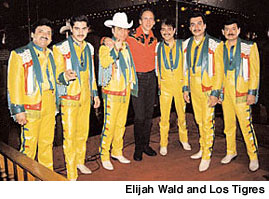 Reviews of "Narcocorrido" online:
Reviews of "Narcocorrido" online:
Radio interviews about "Narcocorrido":
For historical background: Jaime Nicolopulos’s page at the University of Texas
For historical recordings from the 1920s on, and rootsy Texas albums, Arhoolie Records
For LA’s main "gangsta corrido" label, Cintas Acuario
I highly recommend Sam Quiñones’s book, True Tales from Another Mexico, which has a great chapter on Chalino, and fascinating stories of Mexican life and culture.